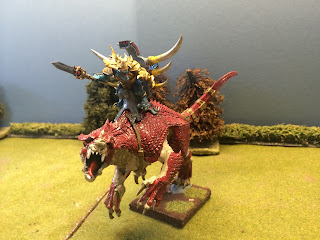Following an unsuccessful campaign in Sicily, Pyrrhus returned to Italy to once again challenge the might of Rome. Attacking towards Roman territory he found his way blocked by Consul Manius at the head of several legions. Pyrrhus attempted a night attack against the Roman camp but his troops became lost and ended-up fighting Manius in an open plan flanked by wooded hills.
In this battle the Romans had a fortified camp for additional support. We treated this as an area of difficult terrain. The occupants (two SI with Javelins and two SI as Crossbows - the artillery) each counts as a separate light division while within the camp.
The Pyrrhic army was of the "classic" type - lots of pike phalanx supported by 3 units of cavalry, some lights and a unit of elephants. The cavalry and lights split between the wings, with the elephants in the centre in the hopes of disrupting the Romans.
 |
| Pyrrhic left |
 |
| Pyrrhic centre - elephants to the fore |
 |
| Pyrrhic right with the Companions in reserve |
The Romans deployed a solid mass of infantry immediately in front of the fortified camp. Their left contained all the cavalry with support from slingers and the Spanish LHI. The right was held by the Triarii and several units of Velites.
 |
| Roman left with the massed mounted |
 |
| Roman centre and left |
 |
| Roman right with the Triarii |
For this game I had a rare chance to breakout my Roman marching camp. This is scratch built from artist mounting board with the facing from a sand/paint mix. It was not expected to play much of a role in the game but did break-up the board.
 |
| Romans defending the camp |
 |
| Camp's eye view of the action |
Having deployed with a heavily weighted left the Romans advanced rapidly against the Successor right, hoping to flank them before the phalanx could reach the Roman main lines. The Successors looked to counter with the Companions and elite pikes trying to block the attack.
 |
| Pyrrhus repositions his right |
On the Roman right the Triarii advanced smartly to cut down the Greek cavalry's space and threaten the left of the phalanx.
 |
| Roman right counters the Greek advances. |
The Pyrrhic forces advanced at full speed in the centre seeking battle in the centre where they had a clear edge.
 |
| Trundle trundle |
 |
| Heavy metal on the move - well mostly resin actually... |
On the Roman left the horse advanced in pursuit of the Successors lights and in attempt to get beyond the phalanx's flank. A good plan usually but on this occasion they probably overran and ended-up too far towards table edge.
 |
| Roman horse chases down some skirmishers |
 |
| Spanish move up but are blocked by some pikes |
Rather penned-in the Roman HC found themselves under threat from the flanks and under sustained, but largely unproductive, archery fire. As the mists cleared the Spanish caught against the elite pike, one unit of HC was routed by a rear Light Infantry charge and the second being lined-up by the Companions. Not a great mid-game on the Roman left.
 |
| Companions covering the flanks |
 |
| Spot of bother for the Roman lef |
As the main heavy infantry lines came together the early action went in favour of Rome. The elephants took heavy damage and as some of the pikes were deployed wide to extend the line they faced two opponents.
 |
| The hit comes in - Romans ahead at the start |
 |
| Elephants are roughly handled |
On the Roman left the Greeks were able to perform a combat and bear-down on the Triarii flanks.
 |
| The flank is turned |
The Triarii quickly fell but in a rare stroke of luck, fire from the bolt shooters in the camp was able to destroy the weakened Greeks and prevent them causing further damage. The respite was temporary though and losses in the centre combined with the destruction of the cavalry meant a 7-5 loss for the Romans.
 |
| Gaps open on both sides |
 |
| The Roman line crumbles |
It is hard to point to a single error that led to Roman defeat, rather a number of bad manoeuvres and some rules mistakes that allowed the Successors to escape harm at key points.
The final verdict
So the campaign ended 3-2 in favour of Pyrrhus with Romans and Carthaginians each recording a win, which is an improvement on history.
The Pyrrhic army is a potent one although elephants are less deadly in Armati than they proved in the historic wars. Its main issue is that the infantry is costly and so the line will always be shorter than the enemies.




















































